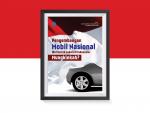Pengembangan Mobil Nasional Bermerek Lokal di Indonesia: Mungkinkah
Keywords:
Mobil Nasional, PengembanganSynopsis
Fenomena mobil nasional yang kembali digulirkan oleh Wali Kota Solo saat itu, Joko Widodo, ternyata tidak mendapat respons positif dari sebagian pihak di tanah air. Mereka menilai bahwa teknologi yang digunakan pada mobil nasional belum dapat bersaing dengan mobil yang sudah lebih dulu ada di Indonesia, seperti mobil dari Amerika Serikat, Jepang, atau Eropa. Di sisi yang lain, pembelajaran pengembangan teknologi mobil ini bisa menggerakkan peningkatan kualitas SDM dan multiplikasi dampak terhadap ekonomi. Tampaknya, tidak hanya karena faktor teknologi, faktor ekonomi dan politik turut pula menggerus keinginan masyarakat untuk memiliki mobil nasional. Untuk itu, di dalam bunga rampai ini juga dibahas alternatif masukan terkait persoalan apa saja yang dapat dilakukan oleh beragam pihak agar mobil nasional bisa bersaing dengan mobil-mobil buatan luar negeri sehingga harapan untuk memiliki mobil nasional dapat terwujud.
Downloads
References
Aswicahyono, H., Hill, H., & Narjoko, D. (2010a). Industrialisation after a deep economic crisis: Indonesia. Journal of development studies. 46(6): 1084–1108.
Aswicahyono, H., Basri, M. C., & Hill, H. (2010b). How not to industrialise? Indonesia’s automotive industry. Bulletin of Indonesia economic studies 36(1): 209–241.
Beeson, M. (1999). Developmental state in East Asia: A comparison of the Japanese and Chinese experiences. Asian perspective 33(2): 5–39.
Business Motor International. (2011). Indonesia autos report Q4 2011. London: Business Motor International.
Chalmers, I. (1996). Konglomerasi: Negara dan modal dalam industri otomotif Indonesia, 1950–1985. Jakarta: Gramedia Pustaka Utama.
Friedman, T. L. (2007). e world is at: A brief history of the twenty- rst century. New York, NY: Picador.
Johnson, C. (1982). MITI and the Japanese miracle: e growth of industrial policy, 1925–1975. Standford, CA: Standford University Press.
____________. (1987). Political institutions and economic performance: e government-business relationship in Japan, South Korea, and Taiwan. In Fredric Deyo (Ed.), e political economy of the new Asian industrialism, pp. 136–164. Ithaca, NY: Cornell University Press.
____________. (1999). e developmental state: Odyssey of a Concept. In Meredith Woo-Cumings (Ed.), e developmental state, pp. 32–60. Ithaca, NY: Cornell University Press.
Nehru, V. (2013). Manufacturing in India and Indonesia: Performance and policies. Bulletin of Indonesian economic studies 49(1): 35–60.
Reinert, E. S. (2007). How rich countries got rich and why poor countries stay poor. London: Constable.
Smith, A. (1776). An inquiry into the nature and causes of the wealth of nations. Edited with an introduction, notes, marginal summary, and index by Ed- win Cannan; new preface by George J. Stigler. ElecBook Classics.
ee, K. W. (2000). e impact of the economic crisis on Indonesia’s manu- facturing sector. e developing economies 38(4): 420–453.
World Economic Forum. (2013). Manufacturing for growth. Strategies for driving growth and employment. Volume 3: Manufacturing Value Chains Driving Growth. Geneva: World Economic Forum.
Woo-Cumings, M. (1999). Introduction: Chalmers johnson and the politics of nationalism and development. In Meredith Woo-Cumings (Ed.), e developmental state, pp. 1–31. Ithaca, NY: Cornell University Press.

Downloads
Published
Categories
License

This work is licensed under a Creative Commons Attribution-NonCommercial-ShareAlike 4.0 International License.






























